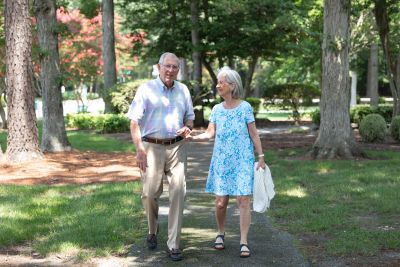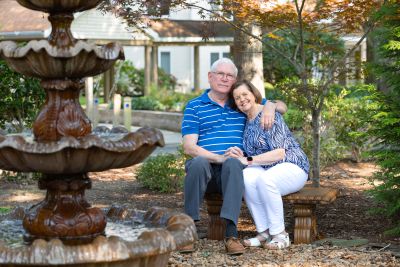 As we enter our golden years, it’s not uncommon to experience anxiety after retirement, particularly when it comes to long-term living arrangements. Making the decision to move into a retirement community — and choosing the best time to move — is rarely simple, especially for senior couples. Many feel they can’t decide whether to move or not because of complex personal circumstances or concerns about life in a new place.
As we enter our golden years, it’s not uncommon to experience anxiety after retirement, particularly when it comes to long-term living arrangements. Making the decision to move into a retirement community — and choosing the best time to move — is rarely simple, especially for senior couples. Many feel they can’t decide whether to move or not because of complex personal circumstances or concerns about life in a new place.
Here’s a look at four common barriers couples face when considering a move to a retirement community and how continuing care retirement communities (CCRCs) can help ease those transitions.
1. One Spouse Is Ready, and the Other Isn’t
One of the most common challenges in deciding when to move into a retirement home arises when one spouse needs or wants to move into a senior living environment and the other doesn’t. The reasons vary: One partner may have increasing health or memory care needs, while the other is still active and independent. Or perhaps one spouse is emotionally ready for a move, while the other fears losing their autonomy.
These mixed needs can be difficult to reconcile, especially if one spouse is reluctant to live in a setting that doesn’t reflect their current lifestyle. If you’re asking yourself “Am I making the right decision to move?”, bear in mind that postponing a move can compromise care for the spouse in need. This tension often leads to emotional and logistical strain as partners try to balance safety, independence, and shared life goals.
However, using open communication, keeping an open mind, touring communities together, and discussing future care needs can help. So can considering some high-quality CCRCs. These senior living communities offer multiple levels of care — independent living, assisted living, skilled nursing, and memory care — all on one campus. This means couples can remain together in one location, even as their care needs diverge.
 2. Concerns About Health Care Access in Rural Areas
2. Concerns About Health Care Access in Rural Areas
Health care accessibility is another major consideration, especially in rural communities.
However, innovative efforts are underway to close that gap, and Virginia’s Northern Neck is a great example of this in action. As VCU Health reports, expanded rural outreach and telehealth offerings are making specialty care more available in regions such as the Middle Peninsula and Northern Neck.
VCU Health’s Tappahannock Hospital, for example, has become a reliable resource for nearby seniors, offering services ranging from emergency care to rehabilitation. Bon Secours Rappahannock General reports high patient satisfaction scores and has been recognized by the Women’s Choice Award. In addition, Virginia recently ranked second in the nation for hospital safety.
Still, many couples want the added security of living where health support is built into their daily environment. That’s where CCRCs shine. Many offer on-site medical care, 24/7 emergency response, coordinated health services, and off-campus transportation, providing peace of mind even in more remote regions. For couples in rural areas, CCRCs eliminate the burden of navigating far-off appointments or worrying about emergency access.
3. Wanting to Renovate a Home (or Enjoy Renovations) Before Selling
Many couples delay moving into a retirement community because they want to finish long-planned home renovations. Some feel emotionally invested in seeing the project through; others simply want to enjoy the upgrades before putting the house on the market.
While this is understandable, it can become a costly and time-consuming roadblock. Sellers often underestimate the time and effort involved in preparing a home for sale, especially when significant updates are needed. Holding off on a move may mean putting off much-needed care or social connection.
CCRCs help shift this mindset by offering appealing, move-in-ready residences with modern amenities, customizable spaces, and maintenance-free living. Instead of pouring money into a home they plan to leave, couples can invest their energy in a setting designed for their future — complete with fitness centers, dining options, lifelong learning, and a built-in community.
4. The Emotional and Physical Challenge of Downsizing
Downsizing is one of the most emotionally loaded steps in preparing for a move. Deciding what to keep, what to donate, and what to leave behind can feel overwhelming at first, especially when it involves decades’ worth of possessions, photos, and memories. Seniors may struggle with parting from items tied to loved ones or major life milestones.
Still, this process doesn’t have to be a solitary or rushed experience; in fact, downsizing can be profoundly liberating. Taking this step and moving to a senior living community means less clutter, fewer maintenance worries, and a simpler lifestyle that fosters wellness and community engagement. In addition, many CCRCs offer downsizing support and access to professional organizers.
How to Decide to Move Into Retirement Home Bliss: Embracing CCRCs
CCRCs are designed specifically to address the concerns many couples face when considering a senior living move. They offer:
- Flexible levels of care, allowing couples with different health needs to remain together
- Convenient on-site health care access, which is especially valuable in rural areas
- Maintenance-free homes without the burden of repairs
- Improved home safety and security, including everything from emergency call systems to well-lit walking paths
- Community transition support, including help with downsizing and emotional adjustment
Most importantly, moving to a CCRC gives couples and their families peace of mind.
Choosing to move into a retirement community is a deeply personal decision, and for couples, it can be even more complex. Remember, the barriers are real, but they’re not insurmountable.
By exploring what CCRCs have to offer, couples can find a place that meets both their current needs and future goals — together.
Make Your Worry-Free Move to Senior Living With RWC
Rappahannock Westminster-Canterbury (RWC) is a continuing care community providing the highest-quality living experience for discerning senior adults. Situated on 165 beautiful acres outside the village of Irvington in Virginia’s Northern Neck, RWC attracts residents with its independent and worry-free lifestyle in a tranquil setting as well as a wide variety of wellness resources.
As a CCRC, we offer the best of all worlds with independent living, assisted living, and licensed nursing care on-site. With our Total LifeCare program, we’ve added the security of lifetime residency and prearranged health care services. Should the need for skilled care arise, the only charges over the monthly fee for an apartment or home would be for additional meals and support services.
Our At Home with RWC department delivers personal care, companion care, or nursing care right to residents within our community’s doorstep. All services are monitored by a registered nurse. Enrollees pay a fee to participate in the program. Go to athomerw-c.org to learn more.
Contact us today for lunch and a tour of our beautiful campus. Alternatively, request a brochure to learn more about helping your loved one live their best life at RWC!
